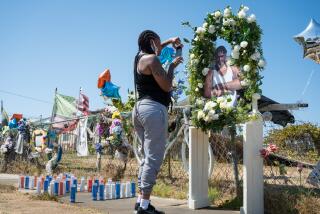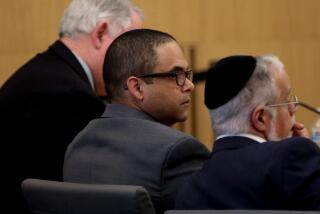George Zimmerman acquitted of murder in Trayvon Martin shooting
- Share via
SANFORD, Fla. — George Zimmerman was acquitted on Saturday of all charges in the shooting of Trayvon Martin, an unarmed black teenager who was slain last year in a confrontation that touched off a national debate about race and guns.
The jury of six women returned the verdict after more than 16 hours of deliberation over two days. Zimmerman was charged with second-degree murder, but the jury had the option of finding him guilty of the lesser charge of manslaughter.
Zimmerman stood stone-faced as the verdict was read. He flashed a smile when the jurors left the courtroom.
Zimmerman, 29, shot Martin, 17, on Feb. 26, 2012, at the Retreat at Twin Lakes, a gated community in Sanford in central Florida.
GRAPHIC: Who’s who in the Trayvon Martin case
Local police had accepted Zimmerman’s explanation that he acted in self-defense, but a special state prosecutor charged the neighborhood watch volunteer after weeks of protests and demonstrations by civil rights leaders across the nation.
Much of the case’s tension began in the six weeks between the shooting and the indictment of Zimmerman on the charge of second-degree murder.
Led by the Martin family and national civil rights leaders, supporters called for Zimmerman, who identifies himself racially with his mother’s Latino heritage, to be charged with the slaying. They argued that if a black man had shot an unarmed white teenager, authorities would have been less likely to accept the self-defense argument. The furor reached all the way to the White House.
“Obviously, this is a tragedy,” President Obama said on March 23, 2012. “I can only imagine what these parents are going through, and when I think about this boy, I think about my own kids, and I think every parent in America should be able to understand why it is absolutely imperative that we investigate every aspect of this, and that everybody pulls together — federal, state and local — to figure out exactly how this tragedy happened.”
“If I had a son, he’d look like Trayvon,” Obama said that day. Martin’s parents “are right to expect that all of us as Americans are going to take this with the seriousness it deserves, and we are going to get to the bottom of exactly what happened,” Obama said.
Zimmerman was living at the gated community and saw Martin, wearing a dark gray hoodie sweat shirt, walking through the complex. Martin had gone to a convenience store where he bought candy and a soft drink and was returning to the home where he was staying with friends. Hoodies would later play a frequent role at protests, offered as symbols of racial profiling.
This year, after weeks of pretrial hearings and maneuvers, jury selection began on June 10 and took nine days. The prosecution took nine more days to present its case, while the defense was able to present its case in fewer than four.
More than 55 witnesses testified during a dramatic trial in which parents of the defendant and the slain teenager testified. At least two witnesses, the friend who heard Martin’s last, fearful words on a cellphone and a Florida medical examiner, became social media celebrities after testifying.
Murder trials often turn on forensic evidence, such as DNA analysis, the use of a weapon and the degree of injury to a suspect or victim. But those questions were less important than the interpretation of what the events meant.
Unlike in many murder cases, there was no mystery about who did the killing because Zimmerman said from the beginning that he had fired a single shot from his 9-millimeter handgun, killing Martin.
Prosecutors used witnesses and documents to present Zimmerman as a police wannabe, an eager neighborhood watch volunteer who was growing more frustrated by crime in his community. When he saw Martin, a stranger, walking on a rainy night, he called authorities to report someone suspicious. The dispatcher advised him to let the police handle it, but Zimmerman ignored that and followed Martin, prosecutors said.
The defense insisted that Zimmerman never followed Martin. Rather, the defense argued, Martin attacked Zimmerman, beating him with dozens of blows and battering his head on the ground. Photographs were admitted showing Zimmerman with a bleeding nose and two lacerations on the back of his head -- injuries that prosecution witnesses said were minor and insignificant.
The prosecution argued that the limited extent of the wounds made Zimmerman’s version of events unbelievable. A barrage of blows should have done more damage to Zimmerman and resulted in more blood on Martin’s clothing, the prosecution said. None of Zimmerman’s DNA was found underneath Martin’s fingernails. None of Martin’s DNA was found on the gun, a prosecution expert said.
The defense, in its cross-examination, questioned those findings. The scene could have been contaminated by the rain that night, and the police did not wrap Martin’s hands in plastic. Martin’s wet clothes were stored in plastic, which could have led to degradation and poor test results as well, the defense argued in its case.
Where the prosecution described Zimmerman as an out-of-control vigilante, the defense portrayed him as a good citizen making a personal sacrifice to help neighbors stay safe. The prosecution said Zimmerman used his knowledge of police procedure and self-defense law to tailor his responses to authorities. The defense said he was trying to better himself by seeking a career in law enforcement.
The defense disputed that Zimmerman’s wounds were minor, but it also argued that their nature was less important than the fear Zimmerman felt: Zimmerman was the victim of a “ground and pound” martial-arts-type attack, the defense argued. Martin was on top beating Zimmerman, who was fearful of worse wounds and reacted by pulling his handgun and firing, defense lawyers said.
There were no direct eyewitnesses to the moments before the confrontation. At least one witness, John Good, one of Zimmerman’s former neighbors, said he saw the pair tussle. Martin, in a dark sweat shirt, appeared to be on top of Zimmerman, Good testified. He said he heard cries for help coming from the person on the bottom.
Those screams were caught in the background of a 911 telephone call made by another resident. Within seconds, there is a gunshot and the screams abruptly end.
An FBI audio expert testified that there was no way for science to determine whose voice was crying out, but the mothers of the dead teenager and the defendant offered clashing interpretations of the recording.
“I heard my son screaming,” Sybrina Fulton, mother of Trayvon Martin, testified.
The defense opened its case with Gladys Zimmerman, George Zimmerman’s mother. She was just as emphatic when, after listening to the recording and being asked who was screaming, she answered, “My son.” When pressed on how she could be so certain, she replied: “Because it’s my son.”
PHOTOS: The controversial case in pictures
Each father also testified that the voice was his son’s. Each relative’s appearance was an emotional reminder to the jury that the events of 2012 continued to have an impact.
The prosecution repeatedly pointed to Zimmerman’s different version of events and argued that what truly happened could only be described by the participants. “One is dead and the other is a liar,” the prosecution argued at several points.
Zimmerman was interviewed by police hours after the shooting, and later again by police. On the afternoon of Feb. 27, the day after the shooting, he walked authorities through the scene, and his statement was recorded on video. All versions were played for the jury, along with recorded calls to dispatchers and selected parts of Zimmerman’s interview with Fox News’ Sean Hannity.
Zimmerman gave substantially the same story in each statement, though the details vary. The prosecution argued that Zimmerman was embellishing at key points to put himself in a better light to sustain his self-defense argument.
The defense dismissed the differences, getting witnesses to agree that they were the types of different accounts one could expect from a person who had gone through a traumatic experience such as an attack and having to kill his assailant.
“This was a tragedy for both families,” defense attorney Mark O’Mara repeatedly said.
Hennessy-Fiske reported from Sanford and Muskal from Los Angeles.
ALSO:
Jury in George Zimmerman trial faces tough task
One year anniversary: candlelight vigil for Trayvon Martin
Rodney King on April 11, 2012: ‘I am Grieving’ for Trayvon Martin
More to Read
Sign up for Essential California
The most important California stories and recommendations in your inbox every morning.
You may occasionally receive promotional content from the Los Angeles Times.












